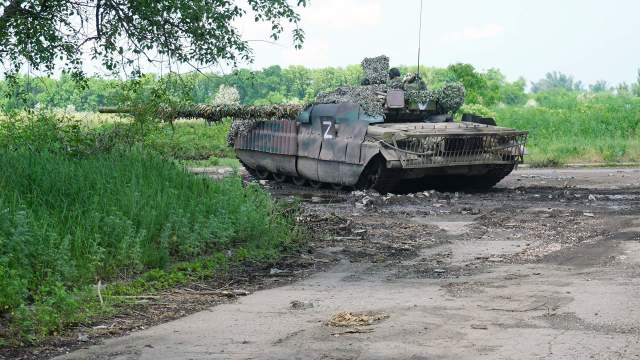T-80 crews mastered artillery firing techniques during their trainingThe fighting during the special military operation taught Russian tankers a lot.
They are now able to fire from closed positions, work in conjunction with the operators of quadrocopters. They are now using these skills, including in the area of Avdiivka, where they support the infantry offensive. Every day, combat vehicles enter positions and destroy enemy fortifications and manpower. Izvestia visited the tank battalion of the 1st Slavic Brigade and saw with their own eyes the combat work of the T-80 gas turbines, talked with their crews, and also felt the full danger of counter-battery fighting when they came under the retaliatory strike of the VFU gunners.
Wings of tanks
— They broke up today. It can be seen how much we gave them," a fighter with the call sign White tells us.
Together we hide behind concrete blocks. Several Ukrainian shells have just exploded nearby. The "Germans", as the VFU militants are called here, tried to destroy the Russian T-80 tank, which had just fired back at their positions in Avdiivka. According to the soldiers of the tank battalion of the 1st Slavic Motorized Rifle Brigade, these were most likely 152-155mm long-range howitzers.
Bely and his colleagues use quadrocopters to track down Ukrainian positions and adjust the combat work of the "eighties" on the radio station. Before our eyes, the tank worked from the so-called closed firing position. This is how conventional artillery fires: howitzers, mortars, multiple rocket launchers. The calculations do not see the target with their own eyes, but they know its coordinates. Then there are mathematical calculations, corrections are made for weather conditions, barrel wear, etc. And they open fire.
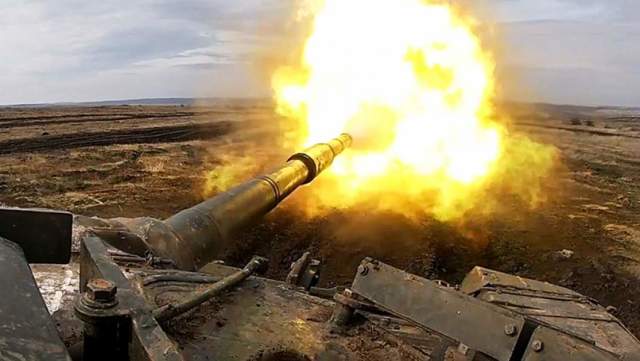
Photo: TASS/Ministry of Defense of the Russian Federation
Image source: iz.ru
But during a special military operation, Russian tankers also perfectly mastered such an artillery method of firing. The combat vehicle enters the position and inflicts fire damage to the enemy. The power of 125-millimeter tank shells is such that they "disassemble" shelters from several attempts.
But if heavy artillery can cover entire areas, then the tank should work much more accurately. Therefore, the quadrocopters became the most important assistant of the "armored tanks" (as tank crews are jokingly called in the troops) of the 1st Donetsk Army Corps. An experienced Quadrica operator easily finds even well-camouflaged Ukrainian positions. And then it's a matter of technique. The crew brings the tank to a combat position, gives sighting shots, receives adjustments and only then inflicts fire damage.
Ukrainian militants suffer heavy losses from such tank-artillery raids. But the classic counter-battery system is not suitable for fighting Russian tanks. These combat vehicles are small and very maneuverable targets. And, unlike artillery, it takes only a few minutes for an experienced crew to take up positions, conduct a fire raid and withdraw.
"Slavic" house
On the outskirts of Donetsk, where fighting has been going on almost continuously for 10 years, we come to a shelter. Tanks disguised from enemy drones are getting ready for work. Cars replace one another in firing positions and in ambushes. A crew of mobilized people is working today. For them, the battles provide an opportunity to smoothly enter combat work, gain experience and complete the combat coordination started at the training grounds.
For a tank commander with the call sign Bilge, gas turbine engines installed on the T-80 are not new. He served in the Navy and says that tank engines are similar, only on ships they are larger in size.
— I'm mobilized. The motherland said "it is necessary" — he became a tanker, — explains Bilge.
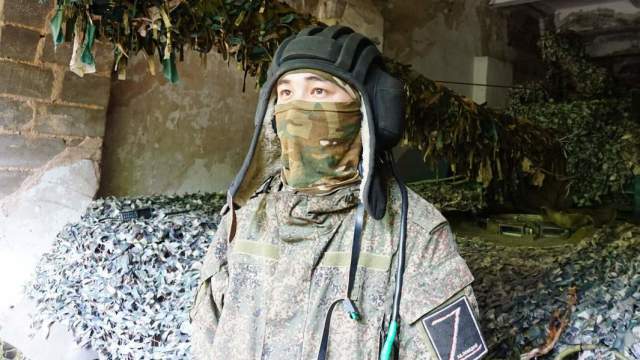
Photo: IZVESTIA/Alexey Ramm
Image source: iz.ru
He and his crew have not yet been in a direct battle "technique against technique", at the moment such battles are rare in the Avdiivka direction. But he has several combat missions to his credit with firing from closed positions.
The spotter of tankers is Filya, a 20—year-old guy from Torez, a city in the DPR. He was still 11 years old, and the fighting was already going on in the area of his hometown. He recalls that as a boy he even met the future head of the republic Alexander Zakharchenko at one of the checkpoints. In 2021, he served on conscription in the DPR army, and in 2022, he was called up during the general mobilization in the republic. Today he is a proofreader of a tank company, a specialty that tankmen did not have until recently, but now it is necessary.
— I am fighting for my deceased friends, for my deceased relatives. My best friend and classmate died in SVO. There were losses. So I'm not going to retreat anywhere, I think that my boys who serve with me share this opinion," explains Filya.
On the chest of his bulletproof vest he has a chevron "Za patsanov".
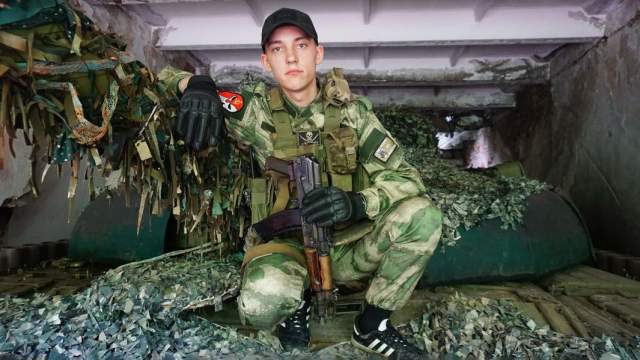
Photo: IZVESTIA/Alexey Ramm
Image source: iz.ru
The T-80 tank itself is hard to recognize. It is covered with camouflage nets, the contours of the tower are hidden by screens made of industrial conveyor belts (a characteristic element of the Donbass modernization of armored vehicles), the sides are covered with additional armor from shell casings and screens. The specifics of the battles in the area of dense buildings and cities leave their mark on the improvement of equipment.
The T-80 is a fast combat vehicle with a gas turbine engine, which is massively supplied to the troops during the SVO. The "Eighties" were loved by many tankers for the speed and quiet sound of the "engine".
— They were accepted perfectly, good relations with the guys. They tell you what you can do and what is not necessary in certain situations. We were trained at the training grounds, but without the practice of combat use, the skills do not work," says a fighter with the call sign Mehan about how he settles in the 1st Slavic brigade.
Mehan is the most adult in the crew. He is also mobilized — from the Urals. In the early 2000s, he participated in the second Chechen campaign. Now he and his crew are seconded to the tankers-"Slavs".
— My main specialty is still in the military service as a driver mechanic. Only then did I manage the "seventy-second". There is a huge difference, this tank — T-80 — is good and frisky," says Mehan.
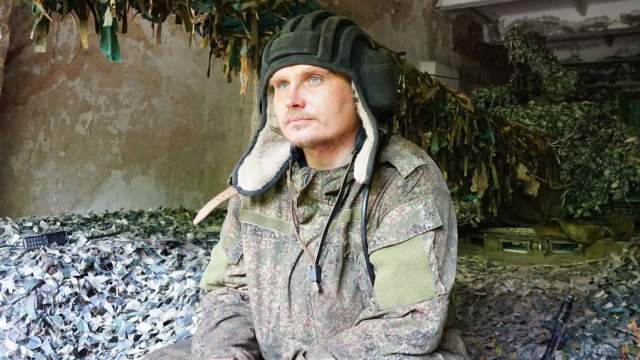
Photo: IZVESTIA/Alexey Ramm
Image source: iz.ru
We walk around the tank with the crew. The fighters lovingly introduce us to their combat vehicle.
— You know, only now, in the course of my, I realized when our grandfathers always wanted: "Just so that there is no war." For us, it seemed like a routine phrase at the time, and we didn't realize its meaning," Mehan suddenly says.
Tank fighters are watching everything that is happening. And they admit that a special military operation was needed.
— A good example was a couple of days ago. It is enough that the enemy has already passed into the Belgorod region. What other evidence is needed for those who said they would not come to us? Everything was clearly shown there," Mehan appeals to all reservists, volunteers and those who hesitate whether to go to service.
Sprint dash
To see live the combat work of the T-80, we have to secretly go to a given point. The crew should take their combat vehicle there in a few minutes. We are immediately warned: there are trenches not far from the positions, and it is better to stay close to them — in case of retaliatory Ukrainian fire.
The crew quickly exits and takes up position. Now the commander and the gunner are working with the operators of the White and Fillet quadrocopters. They point them at the targets and see if there is a need to make adjustments. A sighting shot sounds. Then a short pause: the crew makes corrections. And then there is already fire to kill.
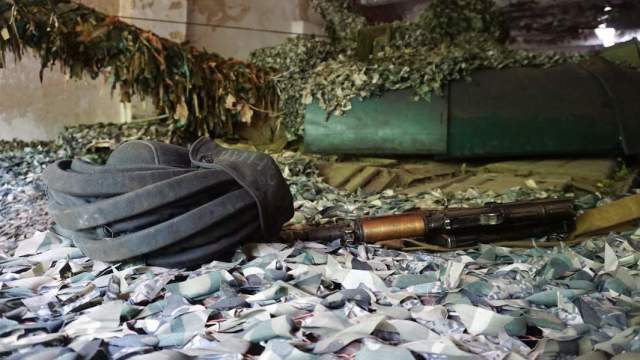
Photo: IZVESTIA/Alexey Ramm
Image source: iz.ru
But the opponent responds almost instantly. Immediately after the fourth shot, we hear a distinctive sound. The first shell of the militants is flying in our direction. Ukrainian counter-battery operators on special radars transmitted to Kiev by NATO countries found an approximate place from where the "eighty" is firing. And immediately begin to work on these coordinates.
However, the first "German" shell falls 200 m from the position of the Russian tank. Therefore, the "Slavs" calmly refine their fire task and begin to leave. The T-80 has already disappeared from view, and the next VFU shells are just beginning to arrive in the area where he worked.
We prefer not to take risks. After the first arrival, we run from the trenches towards shelters. Therefore, we already meet the next volleys of militants behind concrete blocks, catching shortness of breath after a sprint race in protective equipment.
And the tankers-"Slavs" continue their combat work. Every day their tanks take up positions and help the Russian infantry with their fire, which is attacking Avdiivka with heavy fighting.
Dmitry Astrakhan
Alexey Ramm
